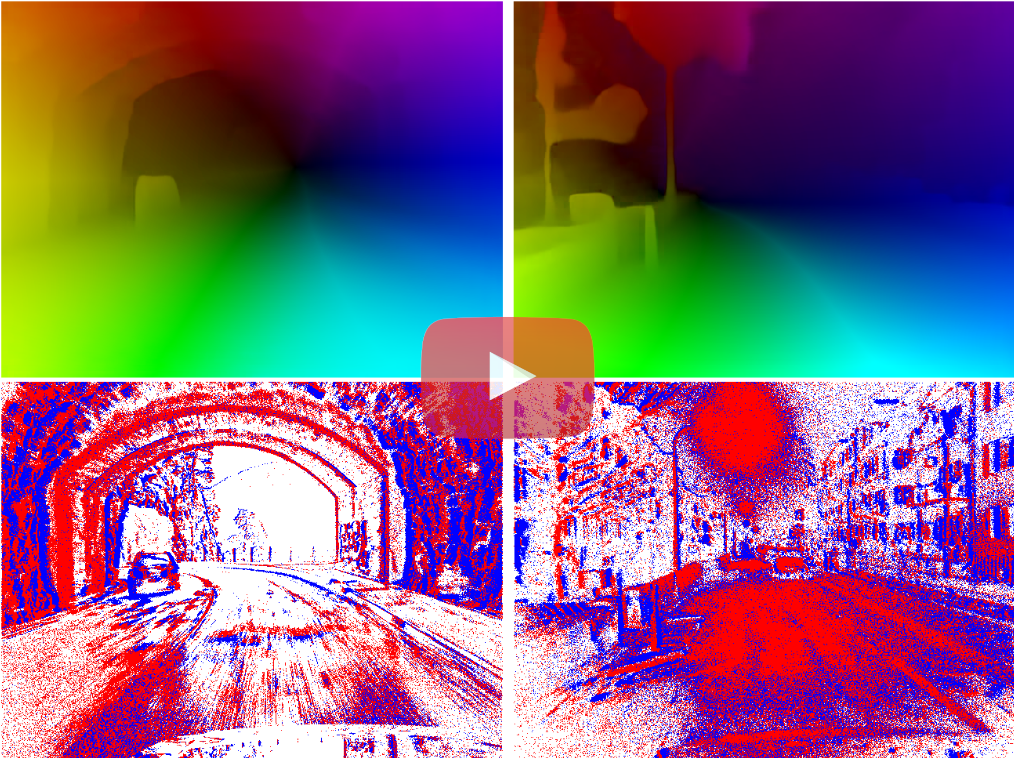E-RAFT: Dense Optical Flow from Event Cameras
This is the code for the paper E-RAFT: Dense Optical Flow from Event Cameras by Mathias Gehrig, Mario Millhäusler, Daniel Gehrig and Davide Scaramuzza.
We also introduce DSEC-Flow (download here), the optical flow extension of the DSEC dataset. We are also hosting an automatic evaluation server and a public benchmark!
Visit our project webpage or download the paper directly here for more details. If you use any of this code, please cite the following publication:
@InProceedings{Gehrig3dv2021,
author = {Mathias Gehrig and Mario Millh\"ausler and Daniel Gehrig and Davide Scaramuzza},
title = {E-RAFT: Dense Optical Flow from Event Cameras},
booktitle = {International Conference on 3D Vision (3DV)},
year = {2021}
}
Download
Download the network checkpoints and place them in the folder checkpoints/:
Checkpoint trained on MVSEC 20 Hz
Checkpoint trained on MVSEC 45 Hz
Installation
Please install conda. Then, create new conda environment with python3.7 and all dependencies by running
conda env create --file environment.yml
Datasets
DSEC
The DSEC dataset for optical flow can be downloaded here. We prepared a script download_dsec_test.py for your convenience. It downloads the dataset directly into the OUTPUT_DIRECTORY with the expected directory structure.
download_dsec_test.py OUTPUT_DIRECTORY
MVSEC
To use the MVSEC dataset for our approach, it needs to be pre-processed into the right format. For your convenience, we provide the pre-processed dataset here:
MVSEC Outdoor Day 1 for 20 Hz evaluation
MVSEC Outdoor Day 1 for 45 Hz evaluation
Experiments
DSEC Dataset
For the evaluation of our method with warm-starting, execute the following command:
python3 main.py --path
For the evaluation of our method without warm-starting, execute the following command:
python3 main.py --path
--type standard
MVSEC Dataset
For the evaluation of our method with warm-starting, trained on 20Hz MVSEC data, execute the following command:
python3 main.py --path
--dataset mvsec --frequency 20
For the evaluation of our method with warm-starting, trained on 45Hz MVSEC data, execute the following command:
python3 main.py --path
--dataset mvsec --frequency 45
Arguments
--path : Path where you stored the dataset
--dataset : Which dataset to use: ([dsec]/mvsec)
--type : Evaluation type ([warm_start]/standard)
--frequency : Evaluation frequency of MVSEC dataset ([20]/45) Hz
--visualize : Provide this argument s.t. DSEC results are visualized. MVSEC experiments are always visualized.
--num_workers : How many sub-processes to use for data loading (default=0)
